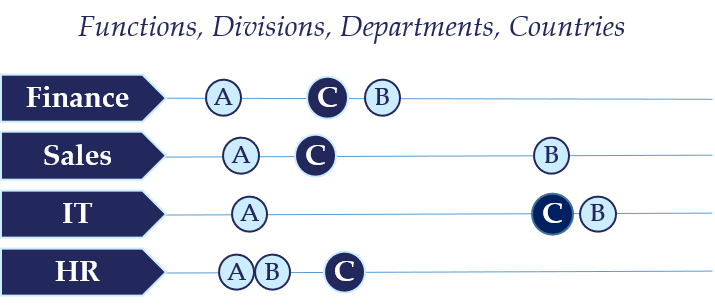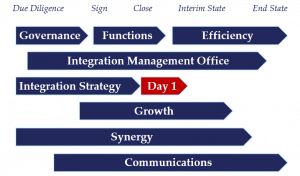Day 1
Day 1 is a key stepping stone to ensuring that an integration delivers maximum value and minimum disruption. It requires a clear focus on critical items, communication with all stakeholders and interim processes that ensure it is “business as usual”.
Given the inherent stresses that will occur across all stakeholders, it can be a challenging time for your teams if they do not have successful integrations experience (and sometimes even if they do), a clear detailed Day 1 plan is essential.
You should understand and deliver clear, relevant Communications, with all stakeholders. These stakeholders will be concerned about the impact on their own businesses (suppliers and customers), and their jobs. Good communication will ensure they support your business during integration and beyond.
Functions such as Finance, HR, IT, Procurement, Facilities have to ensure that systems run, items flow in, processes and controls are in place and the lights will stay on Day 1 and beyond.
Sales and Marketing, are responsible for ensuring a seamless Day 1 for the sales force and customers alike. Taking immediate action on risks and ensuring growth can start.
Day 1 tools and checklists should be used to ensure good, reliable, stress tested detailed Day 1 plans are in place, ensuring all objectives are met.
Governance
The structure of the integration needs to be agreed and put in place at the start, adequately resourced and maintained. Good decisions need to be made in a timely manner. People need to know who to turn to when facing issues they cannot resolve.
Without good guidance, direction and decision making the planning will not go well and delivery will be poor and slow.
All should be fit for purpose, communicated and managed.
Integration Strategy
For each part of the newly designed company you need to understand where the desired end state is. Taking a high level view of the company and then also each functions, divisions, departments, country’s and understanding where each part is today and where it should be in the future. Current state and end state wanted. Each company is A and B current state with C being the desired end state.
Once you have a clear detailed understanding of current ways of working for the businesses and details of the end point, the IMO can ensure that there is a sound business case and that planning and timing will deliver it. Interim scenarios for Day 1, Day 90 and Day 180 are prepared and road maps, milestones and potential roadblocks to delivery designed/assessed.


Integration Management Office
The IMO not only provides co-coordination, tools, checklists and standardisation for all of the functional, operational integration teams it also ensures that the higher level core requirements of a successful integration are in place. Often resourced with integration skills and knowledge.
The IMO ensures all of the Steering Groups and integration teams have adequate resource, skills and cultural mix with the correct overall structure to provide risk management, set-up and governance for all of the integration projects.
The integration high level plan and its cascade to detailed planning and checklists need to be developed with integration teams and clear RACI structure communicated. Business case approvals and change management processes, systems to monitor progress and ensure synergy delivery is visible to business management (in business performance and results).
Growth
To ensure enhanced growth following Day 1, the understanding of how the businesses operate now and the end point must be converted to sales and marketing plans (including branding, materials, and training).
The key elements include customer analysis to avoid customer overlap, or loss, and identify cross sell and up sell opportunities. Product analysis to identify opportunities for a more efficient portfolio, new product development and cost/pricing strategy.
Marketing Strategy development by reviewing Channels, Alliances, & Partnerships; retention or deletion of existing brands; market targeting.
Define changes required to the sales and marketing teams and processes to meet the requirements of the interim and end point.
Of course as you change, your competitors will try to use the opportunity to grow their businesses, you must be able to respond.


Efficiency & Effectiveness
The Interim state and end state business model must ensure that the opportunities to improve both efficiencies and effectiveness are delivered. This means not just identified synergies, but, overlap, duplication, waste, inconsistencies due to the changing strategic direction, standardisation, bottlenecks. The independent integration teams must be able to cut through the politics and constantly review promised delivery to ensure improvements are captured throughout the integration.
Functions
Integration teams for each of the functional areas need to be set up and work within and across boundaries ensuring dependencies are identified, communicated and clearly understood.
Interface points and regular cross functional meetings must be part of the functional plans in addition to being a monitoring process. Synergies and changes are delivered through the functional and business integration plans.


Synergy


Synergies can be identified with integration strategic options, ways of working and costs. Then high level values developed and allocated to streams (function, divisions, businesses and countries).
Workstreams can then prepare individual Business Cases for review and approval via the IMO to ensure they are challenging, achievable, and when consolidated, support the high level deliverables.
Delivery of synergy projects can be complex and you must understand how early decisions affect them longer term. Therefore, a robust and accurate tracking and reporting process within the internal control framework must be implemented to ensure that delivery is kept on track (or the cost of additional support evaluated if slippage occurs). To support this a constant review of potential additional synergies should be part of the framework.
Communications
With plans made in each area, the communications plans need to be created. Communication channels to all stakeholders developed checked and activated.
Communication guidelines prepared. Thinking about what will be delivered, by whom and how are laid down, as well as feedback process set up.
Communications are about retaining people, reducing uncertainty, delivering the business day to day and changes to it, ensuring customers and suppliers understand and the deal is seen as a success on Day 1, Day 180 and beyond.
People need to be fully engaged in the business and the integration with a special focus on Day 1.
As communication is a common issue for employees during normal day to day operations, getting it right during such transformational change is a difficult task. Getting it wrong is expensive.


